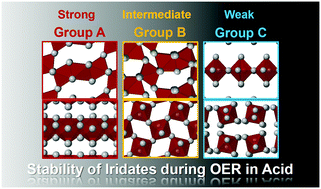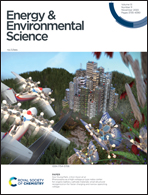Discovery of crystal structure–stability correlation in iridates for oxygen evolution electrocatalysis in acid†
Abstract
One of the critical bottlenecks in many energy-conversion devices associated with the oxygen evolution reaction (OER) is to find adequate catalysts that both show high activity and endure extreme pH conditions of an electrolyte under anodic potentials. As Ir-based compositions are regarded to show better resistance to acidic environments than any other transition metals, a surge of research on many complex iridates recently has been carried out. However, the intrinsic structure–property relationship in iridates remains elusive, although several examples showing exceptional OER activity were reported. Here we discover that eleven different AxIryOz-type oxides (A = Ca, Sr, Ba, Y, Pr, Nd) with high OER activity can be categorized into three distinct groups in terms of the [IrO6] connection geometry. Furthermore, a notable common correlation among the crystal structure, activity variation, and stability during the OER is identified in each of the groups. If the iridates consist of a strong edge- or face-sharing [IrO6] configuration, their stability and activity are preserved during a remarkably large number of anodic cycles. In addition to comparing the OER performance between many high-activity iridates, our findings emphasize that the [IrO6] connectivity is a crucial structural factor governing the overall longevity of Ir-based catalysts.

- This article is part of the themed collection: Energy & Environmental Science Cover Art


 Please wait while we load your content...
Please wait while we load your content...